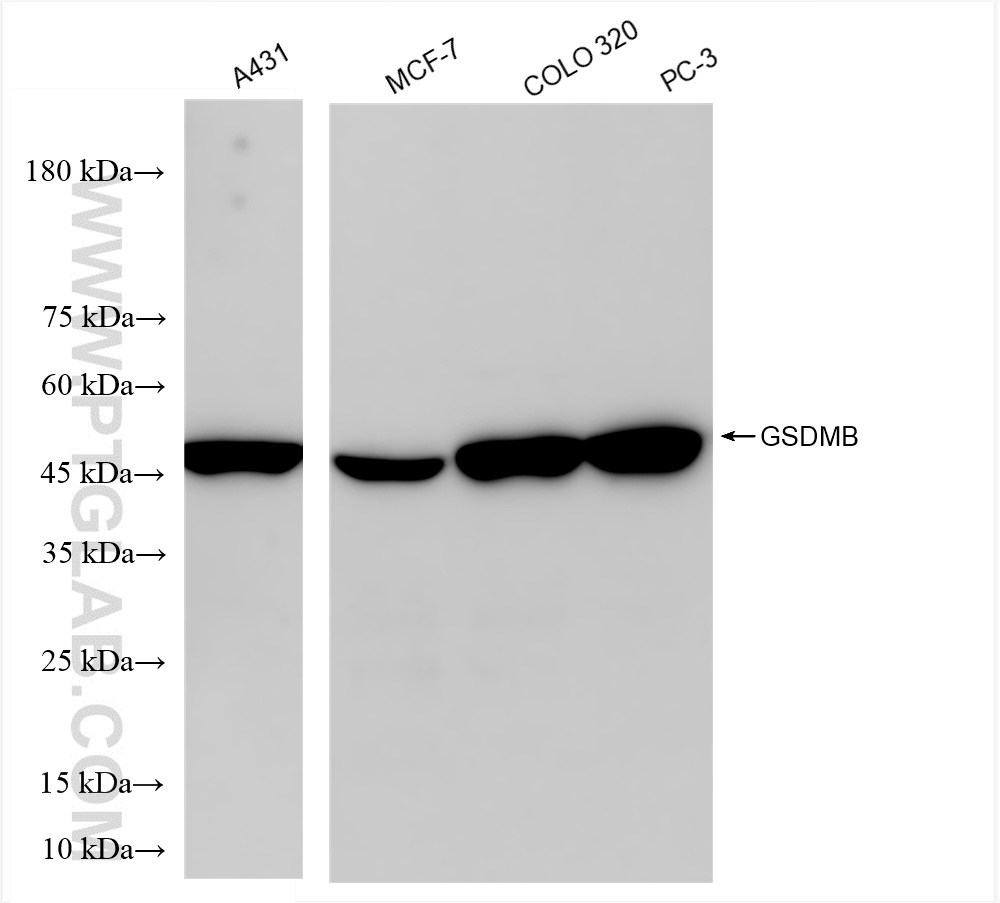Tested Applications
| Positive WB detected in | A431 cells, MCF-7 cells, COLO 320 cells, PC-3 cells |
Recommended dilution
| Application | Dilution |
|---|---|
| Western Blot (WB) | WB : 1:2000-1:10000 |
| It is recommended that this reagent should be titrated in each testing system to obtain optimal results. | |
| Sample-dependent, Check data in validation data gallery. | |
Product Information
86148-1-RR targets GSDMB in WB, ELISA applications and shows reactivity with human samples.
| Tested Reactivity | human |
| Host / Isotype | Rabbit / IgG |
| Class | Recombinant |
| Type | Antibody |
| Immunogen | Peptide Predict reactive species |
| Full Name | gasdermin B |
| Calculated Molecular Weight | 411 aa, 47 kDa |
| Observed Molecular Weight | 47 kDa |
| GenBank Accession Number | BC025682 |
| Gene Symbol | GSDMB |
| Gene ID (NCBI) | 55876 |
| Conjugate | Unconjugated |
| Form | Liquid |
| Purification Method | Protein A purification |
| UNIPROT ID | Q8TAX9 |
| Storage Buffer | PBS with 0.02% sodium azide and 50% glycerol, pH 7.3. |
| Storage Conditions | Store at -20°C. Stable for one year after shipment. Aliquoting is unnecessary for -20oC storage. 20ul sizes contain 0.1% BSA. |
Background Information
GSDMB (Gasdermin B) is a member of the gasdermin family of proteins, which are involved in the regulation of pyroptosis, a form of programmed cell death. GSDMB plays a crucial role in immune responses, particularly against viral respiratory infections. It has also been implicated in various inflammatory and autoimmune diseases, as well as in cancer progression. GSDMB is known for its ability to induce pyroptosis by forming pores in cell membranes, leading to the release of inflammatory cytokines such as IL-1β and IL-18. This process is critical for combating infections and modulating immune responses. GSDMB can be activated by granzyme A (GZMA), which is released from natural killer (NK) cells and cytotoxic T lymphocytes (CTLs), leading to inflammatory cell death and influencing the tumor immune microenvironment. GSDMB also interacts with other signaling pathways, such as the ERK pathway, to regulate cell proliferation and death. (PMID: 40452932; 38066523; 36163066)
Protocols
| Product Specific Protocols | |
|---|---|
| WB protocol for GSDMB antibody 86148-1-RR | Download protocol |
| Standard Protocols | |
|---|---|
| Click here to view our Standard Protocols |



